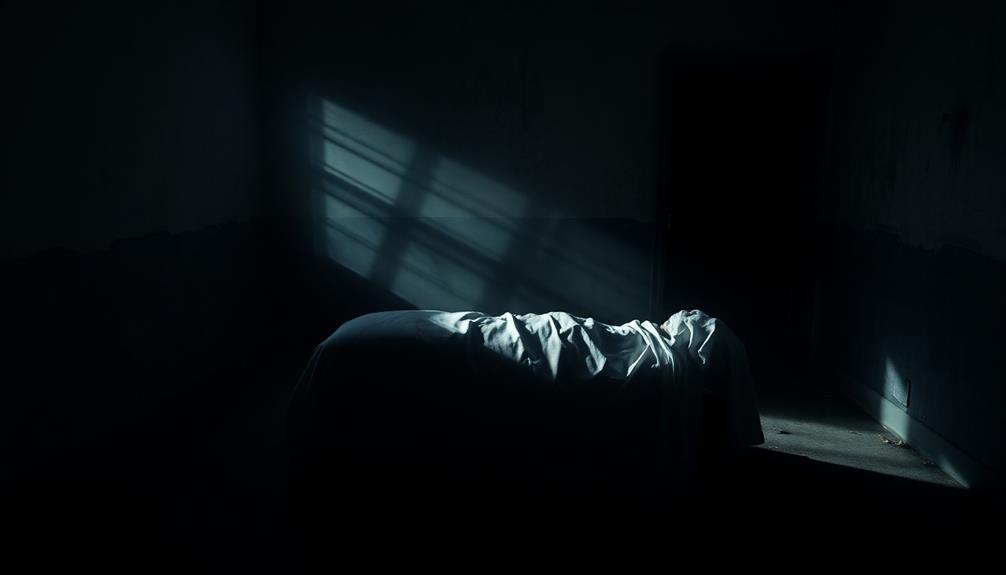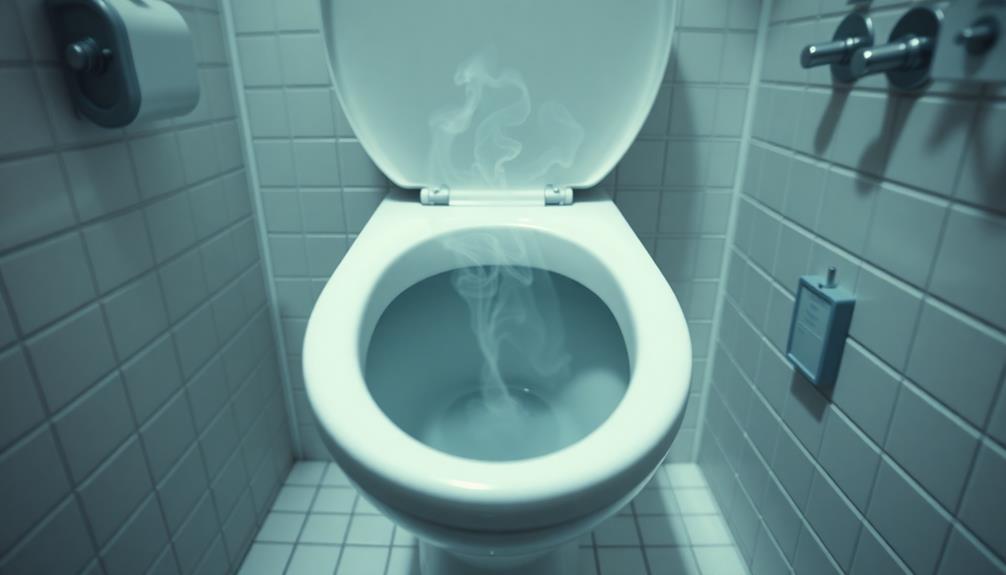A dead body smells bad, like a mixture of rotting meat and terrible decay. This strong odor comes from gases released during decomposition, mainly cadaverine and putrescine. After about 72 hours, the smell gets much worse, often including hints of rotten eggs or a musty scent. Warm, humid places can make the smell stronger, sometimes filling closed spaces like homes or cars. It's important to be aware that this odor can cause health issues, so protective gear is crucial during cleanup. If you want to understand how this happens and why it matters, there's much more to uncover!
Key Takeaways
- The smell of a dead body is primarily characterized by the strong odors of cadaverine and putrescine, resembling rotting meat.
- Odors evolve through decomposition stages, with the strongest scents occurring around 72 hours post-death during the active decay stage.
- Additional foul scents may include rotten eggs (hydrogen sulfide) and fecal odors (skatole) due to microbial activity.
- Environmental factors, such as temperature and humidity, significantly influence the intensity and nature of the decomposition smell.
- Encountering this smell can evoke emotional reactions, often triggering feelings of grief and memories of loss.
Introduction

When a body begins to decompose, the resulting smell can be profoundly unsettling. You might hear people refer to this as "the smell of death." This smell comes from human decomposition, which releases various gases and chemicals, like cadaverine and putrescine.
At first, the odor can be quite mild, but as time passes, especially during the active decay stage, it becomes incredibly strong and unpleasant.
The smell of a decomposing body can remind you of rotten meat, eggs, or even musty odors. It's important to know that the specific scent can change based on several factors, including the environment and the person's health before they died. For example, someone with stomach cancer might produce a different, putrid aroma.
There are four stages of decomposition: fresh, putrefaction, active decay, and skeletonization. The most intense smells happen during the putrefaction and active decay stages, usually around 72 hours after death.
During this time, chemical compounds like skatole and indole also contribute to the characteristic scents that you might associate with a decomposing body. Understanding these stages can help you grasp the complex nature of human decomposition.
Description of the Smell

The smell of a dead body is often described as an unbearable mix of rotting meat and foul decay. This dead body smell comes from the release of various chemical compounds during the decomposition process. As the body breaks down, gases like cadaverine and putrescine are released, creating a stench that's hard to forget.
Around 72 hours after death, the active decay stage kicks in, which produces particularly strong and pungent odors. You might notice scents reminiscent of rotten eggs due to hydrogen sulfide, or even a strong fecal odor from skatole.
These distinct smells can hit you like a brick and vary based on the cause of death and environmental conditions. Sometimes, you might even catch a whiff that seems sweet, while other times it's purely putrid.
The wide range of aromas makes each experience unique. Understanding these smells can help you grasp the decomposition process better. While it's uncomfortable to think about, recognizing the chemical compounds involved gives you insight into what happens to a body after death.
Source and Composition

Decomposition is the primary source of the distinct smell associated with a dead body. When a body begins to break down, it releases gases like cadaverine and putrescine. These compounds create a foul odor that smells like rotting flesh or fish.
Decomposition happens in stages, and the strongest smells usually occur during the active decay stage. This stage peaks around 72 hours after death, when bacterial activity is at its highest.
As the organic matter breaks down, other chemical compounds are released. For example, skatole gives off a fecal scent, while indole has a musty smell, similar to mothballs. You might also notice hydrogen sulfide, which smells like rotten eggs and can be dangerous in high amounts.
The specific smell can change based on several factors. The environment, temperature, and moisture levels all play a role in how quickly and intensely a body decomposes.
If you ever encounter these smells, know that they come from the natural process of decomposition, a fascinating yet unsettling aspect of life and death.
Typical Scenarios or Environments

Although encountering the smell of a dead body is rare, certain scenarios can lead to such an experience. You might come across this unsettling odor in enclosed spaces, like homes or vehicles, where it can become very strong.
Imagine being in a warm and humid area; this is when the smell becomes particularly intense, resembling rotting meat and other unpleasant scents, like feces and garlic.
In these situations, the body's decomposition releases gases like cadaverine and putrescine, which contribute to the foul odor. If someone has passed away in a hidden or neglected location, the smell can linger, making the air quality poor and affecting your belongings.
When you find yourself in such an environment, it's vital to contact professional biohazard cleanup services. They know how to safely handle the situation, eliminating health hazards and restoring the space.
Emotional or Cultural Associations

Experiencing the smell of a dead body can stir deep emotional reactions, often bringing memories of loss and the reality of mortality to the forefront. This scent often triggers feelings of grief, reminding you of loved ones who've passed away.
In many cultures, the smell of death carries different meanings. Some people may feel fear or repulsion, while others view it as a natural part of life's cycle.
Floral scents you might associate with funerals can symbolize beauty and remembrance, celebrating the lives of those who've died. On the other hand, earthy or natural fragrances may remind you of life's fragility, grounding your understanding of mortality.
Your emotional response to the scent of death can vary greatly based on personal experiences and cultural beliefs. For some, it may evoke sadness, while for others, it might serve as a reminder to cherish life.
Research shows that these olfactory experiences can connect you more deeply to the concept of death, influencing how you cope with grief and loss. Remember, understanding these emotional and cultural associations can help you navigate your feelings about death more effectively.
Health or Safety Considerations

When dealing with the aftermath of a dead body, it's essential to recognize the health and safety risks involved. The decomposition process releases harmful compounds, including dimethyl disulfide, which can create strong odors that might trigger respiratory issues like wheezing or coughing.
You might also notice skin reactions, such as rashes or hives, and watery eyes, indicating potential health risks from exposure.
Dangerous pathogens in the blood and fluids of the human body pose significant threats, so wearing proper protective equipment (PPE) is crucial. Gloves, masks, and goggles can help keep you safe during cleanup.
Moreover, gases like hydrogen sulfide and methane are flammable and toxic, meaning you need to take extra safety precautions when working near decomposing remains.
Being aware of these health hazards isn't just for your safety but also for the well-being of others nearby.
If you're a first responder or part of a cleanup crew, understanding these risks can prevent long-term health effects from exposure to harmful substances.
Always prioritize your health and safety during these challenging situations!
Final Thoughts

Understanding the health and safety risks associated with encountering a dead body provides a foundation for appreciating the profound impact of death, including its unmistakable odor.
The smell of a decomposing body is extremely unpleasant and can be overwhelming. It's mainly caused by gases like cadaverine and putrescine, which resemble the odor of decaying meat. As bacteria break down tissues, other compounds such as hydrogen sulfide and methane are also released, contributing to the foul odor. The smell of a decomposing body is often described as a mix of rotting eggs, sulfur, and decayed flesh. This overwhelming stench can linger in the environment for extended periods, making cleanup and handling particularly challenging.
When decomposition happens, microorganisms remain active, breaking down tissue and releasing even more foul scents. This process intensifies around 72 hours after death, reaching its peak during the active decay phase.
You might notice earthy and fecal notes mixed with hints of hydrogen sulfide, which smells like rotten eggs.
Environmental factors—like temperature and humidity—can also change how strong or different the smell can be.
Because everyone reacts differently to this scent, it can evoke various emotional responses, often reminding people of loss.
Frequently Asked Questions
What Is the Closest Smell to a Dead Body?
When you think about the closest smell to a dead body, you might consider decaying meat or spoiled food. Both share a pungent, foul odor that can evoke a similar sense of disgust and unease.
How Long After Death Does a Body Smell?
A body starts to smell noticeably within 24 to 72 hours after death. The odor intensifies as decomposition progresses, peaking around 3 to 10 days, influenced by environmental factors like temperature and humidity.
How Far Away Can You Smell a Dead Body?
You can smell a dead body from several hundred feet away, depending on conditions. In optimal situations, the odor might reach up to a mile. Factors like humidity and soil type can affect this distance.
What Do Burning Bodies Smell Like?
When you encounter burning bodies, you'll notice a complex scent. It often resembles burnt meat mixed with acrid smoke. Higher temperatures can lessen some odors, while synthetic materials add unique, pungent notes to the aroma.









